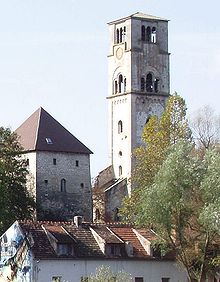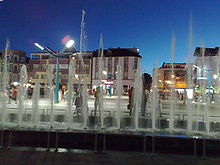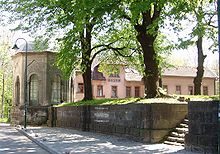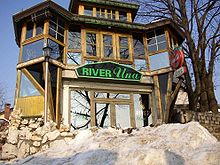
Bihac
Encyclopedia



Bosnia and Herzegovina
Bosnia and Herzegovina , sometimes called Bosnia-Herzegovina or simply Bosnia, is a country in Southern Europe, on the Balkan Peninsula. Bordered by Croatia to the north, west and south, Serbia to the east, and Montenegro to the southeast, Bosnia and Herzegovina is almost landlocked, except for the...
, in the Bosanska Krajina
Bosanska Krajina
Bosanska Krajina or Bosnian Frontier is a geographical region, a subregion of Bosnia, in western Bosnia and Herzegovina enclosed by three rivers - Sava, Una and Vrbas. It is also a historic, economic and cultural entity of Bosnia and Herzegovina....
region. Bihać is located in the Una-Sana Canton
Una-Sana Canton
The Una-Sana Canton is one of the 10 cantons of Bosnia and Herzegovina. It is located in the northwest of the country and has been named after the rivers Una and Sana. The center of canton government is Bihać.-Population:...
(Canton I) in the Federation of Bosnia and Herzegovina
Federation of Bosnia and Herzegovina
The Federation of Bosnia and Herzegovina is one of the two political entities that compose the sovereign country of Bosnia and Herzegovina . The two entities are delineated by the Inter-Entity Boundary Line...
.
History
The town was first mentioned as early as 1260 as property of a church in TopuskoTopusko
Topusko is a spa town in Sisak-Moslavina County, Croatia.-Demographics:The population of the town of Topusko is 798, with a total of 3,219 people in the municipality . There are 2045 Croats , 954 Serbs and 65 Bosniaks .Prior to the war, there were 1,587 people in Topusko, of which most were Serbs...
, Croatia
Croatia
Croatia , officially the Republic of Croatia , is a unitary democratic parliamentary republic in Europe at the crossroads of the Mitteleuropa, the Balkans, and the Mediterranean. Its capital and largest city is Zagreb. The country is divided into 20 counties and the city of Zagreb. Croatia covers ...
in a document by the Hungarian-Croatian king Bela IV, and became a free city in 1262. Bihać was the temporary capital of the Croatian Kingdom
Croatia in personal union with Hungary
Kingdom of Croatia after the succession crisis become a part of Kingdom of Hungary and — depending on sources — either was incorporated into Hungary or Croatia existed in a personal union with Hungary....
. It lost its civic status in the 14th century following dynastic struggles in the kingdom, and became a property of the Frankopan
Frankopan
The Frankopans are a Croatian noble family. Also called Frankapan, Frangepán in Hungarian, and Frangipani in Italian.The Frankopan family is the leading princely Croatian aristocratic family which dates back to the 12th Century and even earlier to Roman times...
nobles. In the 16th century it passed under direct royal rule, when battles with the Ottoman Empire
Ottoman Empire
The Ottoman EmpireIt was usually referred to as the "Ottoman Empire", the "Turkish Empire", the "Ottoman Caliphate" or more commonly "Turkey" by its contemporaries...
had begun. The town of Bihać, in the region of the same name, withstood the Ottoman attacks until it fell with the Bosnia sanjak (in 1592).
The Bihać fort would become the westernmost fort taken by the Ottoman army over a hundred years later, in 1592 under the Bosnian vizier Hasan-pasha Predojević
Hasan Predojević
Hasan Predojević, Telli Hasan Paşa, Gazi Hasan-paša Predojević, was a military leader of the Ottoman army. Born Niko Predojević in Herzegovina, he was given the name Hasan after he converted to Islam.During the rule of Murat III he became Sandjakbey of the Sanjak of Segedin where he stayed until...
. The city was initially made the center of the Bihać sanjak
Sanjak
Sanjaks were administrative divisions of the Ottoman Empire. Sanjak, and the variant spellings sandjak, sanjaq, and sinjaq, are English transliterations of the Turkish word sancak, meaning district, banner, or flag...
, part of the Bosnian pashaluk
Pashaluk
Pashaluk or Pashalik is a term for one type of the Subdivisions of the Ottoman Empire.It is the abstract word derived from pasha, denoting the quality, office or jurisdiction of a pasha or the territory administered by him....
. It was demoted in 1699 to become part of the sanjak of Bosnia, during the period of intense border wars between the Habsburg
Habsburg
The House of Habsburg , also found as Hapsburg, and also known as House of Austria is one of the most important royal houses of Europe and is best known for being an origin of all of the formally elected Holy Roman Emperors between 1438 and 1740, as well as rulers of the Austrian Empire and...
monarchy and the Ottoman Empire. In 1865 it became the center of its own sanjak, but this lasted only until 1878, when all of Bosnia was occupied by Austria-Hungary
Austria-Hungary
Austria-Hungary , more formally known as the Kingdoms and Lands Represented in the Imperial Council and the Lands of the Holy Hungarian Crown of Saint Stephen, was a constitutional monarchic union between the crowns of the Austrian Empire and the Kingdom of Hungary in...
.
A period of peace followed, marked by the 1888 bringing down of the fortress walls that separated the inner city from the outskirts. The new government had several schools and civic facilities built, which boosted the city's growth. It remained prosperous after the establishment of Yugoslavia
Yugoslavia
Yugoslavia refers to three political entities that existed successively on the western part of the Balkans during most of the 20th century....
, the center of the western Bosnian region, though its growth was impaired by the Great Depression
Great Depression
The Great Depression was a severe worldwide economic depression in the decade preceding World War II. The timing of the Great Depression varied across nations, but in most countries it started in about 1929 and lasted until the late 1930s or early 1940s...
in the 1930s.
During World War II
World War II
World War II, or the Second World War , was a global conflict lasting from 1939 to 1945, involving most of the world's nations—including all of the great powers—eventually forming two opposing military alliances: the Allies and the Axis...
, Bihać, along with the rest of Bosnia
Bosnia and Herzegovina
Bosnia and Herzegovina , sometimes called Bosnia-Herzegovina or simply Bosnia, is a country in Southern Europe, on the Balkan Peninsula. Bordered by Croatia to the north, west and south, Serbia to the east, and Montenegro to the southeast, Bosnia and Herzegovina is almost landlocked, except for the...
, was a part of the Independent State of Croatia
Independent State of Croatia
The Independent State of Croatia was a World War II puppet state of Nazi Germany, established on a part of Axis-occupied Yugoslavia. The NDH was founded on 10 April 1941, after the invasion of Yugoslavia by the Axis powers. All of Bosnia and Herzegovina was annexed to NDH, together with some parts...
. The city also served as headquarters for the Communist army of Josip Broz Tito
Josip Broz Tito
Marshal Josip Broz Tito – 4 May 1980) was a Yugoslav revolutionary and statesman. While his presidency has been criticized as authoritarian, Tito was a popular public figure both in Yugoslavia and abroad, viewed as a unifying symbol for the nations of the Yugoslav federation...
, the seat of the first AVNOJ
AVNOJ
The Anti-Fascist Council of the People's Liberation of Yugoslavia, known more commonly by its Yugoslav abbreviation AVNOJ, was the political umbrella organization for the national liberation councils of the Yugoslav resistance against the World War II Axis occupation, eventually becoming the...
session in 1942 and the center of the anti-fascist resistance. As such, it became a target of the occupying powers and the Germans retook it in 1943 and held it until 1945 and their final defeat.
Bihać suffered the destruction of many buildings during the Bosnian War
Bosnian War
The Bosnian War or the War in Bosnia and Herzegovina was an international armed conflict that took place in Bosnia and Herzegovina between April 1992 and December 1995. The war involved several sides...
, when the area around the city was under siege by joint forces composing of Bosnian Serb
Republika Srpska
Republika Srpska is one of two main political entities of Bosnia and Herzegovina, the other being the Federation of Bosnia and Herzegovina...
, Croatian Serb, and Serbian-backed Bosniaks for over three years, until the summer of 1995 when the siege was broken in the beginning of the Croats' Operation Storm
Operation Storm
Operation Storm is the code name given to a large-scale military operation carried out by Croatian Armed Forces, in conjunction with the Army of the Republic of Bosnia and Herzegovina, to gain back control of parts of Croatia which had been claimed by separatist ethnic Serbs, since early...
conjoined with Bosnian forces under General Atif Dudaković
Atif Dudakovic
Atif Dudaković is a former general in the Bosnian army, commanding the army's Fifth Corps before becoming the general commander of the Federation of Bosnia and Herzegovina army...
.
Demographics
| Population of Bihać municipality | ||||||
|---|---|---|---|---|---|---|
| Year of census | Bosniaks | Serbs | Croats | Yugoslavs | Others or unknown | Total |
| 1971 | 37,325 (64.14%) | 12,096 (20.78%) | 6,824 (11.72%) | 1,133 (1.94%) | 807 (1.38%) | 58,185 |
| 1981 | 40,041 (61.09%) | 11,093 (16.92%) | 5,855 (8.93%) | 7,364 (11.23%) | 1,191 (1.81%) | 65,544 |
| 1991 | 46,737 (66.07%) | 12,689 (17.93%) | 5,580 (7.88%) | 4,356 (6.15%) | 1,370 (1.93%) | 70,732 |
Settlements
BihaćTotal: 45,553
- 27,418 - 60.18% BosniaksBosniaksThe Bosniaks or Bosniacs are a South Slavic ethnic group, living mainly in Bosnia and Herzegovina, with a smaller minority also present in other lands of the Balkan Peninsula especially in Serbia, Montenegro and Croatia...
- 8,218 - 18.04% SerbsSerbsThe Serbs are a South Slavic ethnic group of the Balkans and southern Central Europe. Serbs are located mainly in Serbia, Montenegro and Bosnia and Herzegovina, and form a sizable minority in Croatia, the Republic of Macedonia and Slovenia. Likewise, Serbs are an officially recognized minority in...
- 4,805 - 10.54% CroatsCroatsCroats are a South Slavic ethnic group mostly living in Croatia, Bosnia and Herzegovina and nearby countries. There are around 4 million Croats living inside Croatia and up to 4.5 million throughout the rest of the world. Responding to political, social and economic pressure, many Croats have...
- 4,020 - 8.82% YugoslavsYugoslavsYugoslavs is a national designation used by a minority of South Slavs across the countries of the former Yugoslavia and in the diaspora...
- 1,092 - 2.42% others and unknown
Orašac
Total: 2,574
- 2,498 - 97.04% BosniaksBosniaksThe Bosniaks or Bosniacs are a South Slavic ethnic group, living mainly in Bosnia and Herzegovina, with a smaller minority also present in other lands of the Balkan Peninsula especially in Serbia, Montenegro and Croatia...
- 49 - 1.90% SerbsSerbsThe Serbs are a South Slavic ethnic group of the Balkans and southern Central Europe. Serbs are located mainly in Serbia, Montenegro and Bosnia and Herzegovina, and form a sizable minority in Croatia, the Republic of Macedonia and Slovenia. Likewise, Serbs are an officially recognized minority in...
- 1 - 0.03% CroatsCroatsCroats are a South Slavic ethnic group mostly living in Croatia, Bosnia and Herzegovina and nearby countries. There are around 4 million Croats living inside Croatia and up to 4.5 million throughout the rest of the world. Responding to political, social and economic pressure, many Croats have...
- 11 - 0.42% YugoslavsYugoslavsYugoslavs is a national designation used by a minority of South Slavs across the countries of the former Yugoslavia and in the diaspora...
- 15 - 0,58% others and unknown
Brekovica
Total: 1,833
- 1,779 - 97.05% BosniaksBosniaksThe Bosniaks or Bosniacs are a South Slavic ethnic group, living mainly in Bosnia and Herzegovina, with a smaller minority also present in other lands of the Balkan Peninsula especially in Serbia, Montenegro and Croatia...
- 1 - 0.05% CroatsCroatsCroats are a South Slavic ethnic group mostly living in Croatia, Bosnia and Herzegovina and nearby countries. There are around 4 million Croats living inside Croatia and up to 4.5 million throughout the rest of the world. Responding to political, social and economic pressure, many Croats have...
- 1 - 0.05% SerbsSerbsThe Serbs are a South Slavic ethnic group of the Balkans and southern Central Europe. Serbs are located mainly in Serbia, Montenegro and Bosnia and Herzegovina, and form a sizable minority in Croatia, the Republic of Macedonia and Slovenia. Likewise, Serbs are an officially recognized minority in...
- 4 - 0.21% YugoslavsYugoslavsYugoslavs is a national designation used by a minority of South Slavs across the countries of the former Yugoslavia and in the diaspora...
- 48 - 2.61% others and unknown
Ripač
Total: 1,724
- 1,297 - 75.23% BosniaksBosniaksThe Bosniaks or Bosniacs are a South Slavic ethnic group, living mainly in Bosnia and Herzegovina, with a smaller minority also present in other lands of the Balkan Peninsula especially in Serbia, Montenegro and Croatia...
- 339 - 19.66% SerbsSerbsThe Serbs are a South Slavic ethnic group of the Balkans and southern Central Europe. Serbs are located mainly in Serbia, Montenegro and Bosnia and Herzegovina, and form a sizable minority in Croatia, the Republic of Macedonia and Slovenia. Likewise, Serbs are an officially recognized minority in...
- 12 - 0.69% CroatsCroatsCroats are a South Slavic ethnic group mostly living in Croatia, Bosnia and Herzegovina and nearby countries. There are around 4 million Croats living inside Croatia and up to 4.5 million throughout the rest of the world. Responding to political, social and economic pressure, many Croats have...
- 70 - 4.06% YugoslavsYugoslavsYugoslavs is a national designation used by a minority of South Slavs across the countries of the former Yugoslavia and in the diaspora...
- 6 - 0.34% others and unknown
• Bajrići
• Baljevac
Baljevac
Baljevac is a village in Central Serbia, in the municipality of Obrenovac. According to the 2002 census, Baljevac had 532 inhabitants.-References:...
• Bihać
• Brekovica
Brekovica
Brekovica is a village in the municipality of Bihać, Bosnia and Herzegovina.-References:...
• Bugar
Bugar
Bugar is a village in the municipality of Bihać, Bosnia and Herzegovina....
• Ćukovi
Ćukovi
Ćukovi is a village in the municipality of Bihać, Bosnia and Herzegovina....
• Doljani
• Donja Gata
Donja Gata
Donja Gata is a village in the municipality of Bihać, Bosnia and Herzegovina....
• Dubovsko
Dubovsko
Dubovsko is a village in the municipality of Bihać, Bosnia and Herzegovina.-References:...
• Gorjevac
Gorjevac
Gorjevac is a village in the municipality of Bihać, Bosnia and Herzegovina.-References:...
• Grabež
Grabež
Grabež is a village in the municipality of Bihać, Bosnia and Herzegovina....
• Grmuša
Grmuša
Grmuša is a village in the municipality of Bihać, Bosnia and Herzegovina....
• Hrgar
Hrgar
Hrgar is a village in the municipality of Bihać, Bosnia and Herzegovina....
• Izačić
Izačić
Izačić is a village in the municipality of Bihać, Bosnia and Herzegovina. Its population is a mix of the various Balkan states that border this region.-References:...
• Jankovac
• Jezero
Jezero (Bihać)
Jezero is a village in the municipality of Bihać, Bosnia and Herzegovina....
• Kalati
Kalati
Kalati is a village in the municipality of Bihać, Bosnia and Herzegovina....
• Klisa
• Klokot
• Kula
• Kulen Vakuf
Kulen Vakuf
Kulen Vakuf is a village in the municipality of Bihać, Bosnia and Herzegovina. Kulen Vakuf was the birthplace of the respected Mehmed-beg Kulenović.-References:...
• Lipa
• Lohovo
Lohovo
Lohovo is a village in the municipality of Bihać, Bosnia and Herzegovina.-References:...
• Lohovska Brda
Lohovska Brda
Lohovska Brda is a village in the municipality of Bihać, Bosnia and Herzegovina....
• Mala Peća
Mala Peća
Mala Peća is a village in the municipality of Bihać, Bosnia and Herzegovina.-References:...
• Mali Skočaj
Mali Skočaj
Mali Skočaj is a village in the municipality of Bihać, Bosnia and Herzegovina.-References:...
• Međudražje
Međudražje
Međudražje is a village in the municipality of Bihać, Bosnia and Herzegovina.-References:...
• Muslići
Muslići
Muslići is a village in the municipality of Bihać, Bosnia and Herzegovina....
• Orašac
• Ostrovica
Ostrovica
Ostrovica may refer to:* Ostrovica, Croatia, village in Croatia, near Benkovac, in Lišane Ostrovičke municipality* Ostrovica, Bosnia and Herzegovina, village in Bosnia, near Kulen Vakuf* Ostrovica , village in Serbia, near Niš...
• Papari
Papari
Papari is a village in the municipality of Bihać, Bosnia and Herzegovina.-References:...
• Praščijak
Praščijak
Praščijak is a village in the municipality of Bihać, Bosnia and Herzegovina.-References:...
• Pritoka
Pritoka
Pritoka is a village in the municipality of Bihać, Bosnia and Herzegovina....
• Prnjavor
• Račić
Račić
Račić is a village in the municipality of Bihać, Bosnia and Herzegovina....
• Rajinovci
Rajinovci
Rajinovci is a village in the municipality of Bihać, Bosnia and Herzegovina....
• Ripač
Ripač
Ripač is a village in the municipality of Bihać, Bosnia and Herzegovina.Ripač is the location of a border crossing with Croatia, across Užljebić.-References:...
• Spahići
Spahići
Spahići is a village in the municipality of Bihać, Bosnia and Herzegovina....
• Srbljani
Srbljani
Srbljani is a village in the municipality of Bihać, Bosnia and Herzegovina....
• Teočak
• Turija
• Velika Gata
Velika Gata
Velika Gata is a village in the municipality of Bihać, Bosnia and Herzegovina....
• Veliki Skočaj
Veliki Skočaj
Veliki Skočaj is a village in the municipality of Bihać, Bosnia and Herzegovina.-References:...
• Veliki Stjenjani
Veliki Stjenjani
Veliki Stjenjani is a village in the municipality of Bihać, Bosnia and Herzegovina.-References:...
• Vikići
Vikići
Vikići is a village in the municipality of Bihać, Bosnia and Herzegovina.-References:...
• Vrsta
Vrsta
Vrsta is a village in the municipality of Bihać, Bosnia and Herzegovina....
• Zavalje i Zlopoljac
Zavalje i Zlopoljac
Zavalje is a village in the municipality of Bihać, Bosnia and Herzegovina.-References:...
.
Features


Zagreb
Zagreb is the capital and the largest city of the Republic of Croatia. It is in the northwest of the country, along the Sava river, at the southern slopes of the Medvednica mountain. Zagreb lies at an elevation of approximately above sea level. According to the last official census, Zagreb's city...
to Dalmatia
Dalmatia
Dalmatia is a historical region on the eastern coast of the Adriatic Sea. It stretches from the island of Rab in the northwest to the Bay of Kotor in the southeast. The hinterland, the Dalmatian Zagora, ranges from fifty kilometers in width in the north to just a few kilometers in the south....
so the traffic position is also favorable.
There's also a yearly regatta
Regatta
A regatta is a series of boat races. The term typically describes racing events of rowed or sailed water craft, although some powerboat race series are also called regattas...
held on the Una, as well as the Bihać Summer theatrical event.
Border crossings
Border crossings with CroatiaCroatia
Croatia , officially the Republic of Croatia , is a unitary democratic parliamentary republic in Europe at the crossroads of the Mitteleuropa, the Balkans, and the Mediterranean. Its capital and largest city is Zagreb. The country is divided into 20 counties and the city of Zagreb. Croatia covers ...
are located nearby at Izačić to the west of the city (with the Croatian border post at Ličko Petrovo Selo), and Ripac to the south of Bihać (with the Croatian border post at Užljebić). Bihać is located on the shortest route between Zagreb and the southern part of Croatia's Dalmatian coast.
Education
The University of BihaćUniversity of Bihac
The University of Bihać is a public institution of higher learning founded on July 28, 1997, in Bosnia and Herzegovina. The seat of the university is in an area known as Kulina bana 2/II.The roots of higher education in this area go back much further...
was opened in 1997 and it has seven faculties: technical, economics, law school, biotechnical, pedagogical, medical college, Islamic pedagogical academy.
Economy
Bihać is home to a beer brewery, producing the award winning Preminger.Bihać is currently going through a reconstruction of its main buildings and streets. In 1981 Bihać's GDP per capita was 69% of the Yugoslav average.
People
- Irfan LjubijankićIrfan LjubijankicDr. Irfan Ljubijankić was a Bosnian facial surgeon, classical music composer, politician and diplomat. He was a good friend of Yusef Islam ....
, facial surgeon, classical music composer, politician and diplomat of Bosnia and Herzegovina. - Zele Lipovača, leading member of the Bosnian hard rock band Divlje jagodeDivlje jagodeDivlje Jagode is a Yugoslav and Bosnian hard rock and heavy metal band.-1970s:Divlje Jagode were formed in 1977 in Bihać by guitarist Zele Lipovača...
- Alen IslamovićAlen IslamovicAlen Islamović is a well-known and popular Bosnian singer in Bosnia and Herzegovina and other former Yugoslav republics...
, Bosnian singer, the vocalist of the bands Divlje jagode and Bijelo dugmeBijelo dugmeBijelo dugme was a highly influential former Yugoslav rock band, based in Sarajevo. Active between 1974 and 1989, it is widely considered to have been the most popular band ever to exist in former Socialist Federal Republic of Yugoslavia and one of the most important acts of the Yugoslav rock... - Zlatko DedičZlatko DedicZlatko Dedič is a Slovenian footballer who plays as a striker for 2nd Bundesliga club Dynamo Dresden and the Slovenia national team.-Club career:He started his career with Koper....
, Slovenian football player

